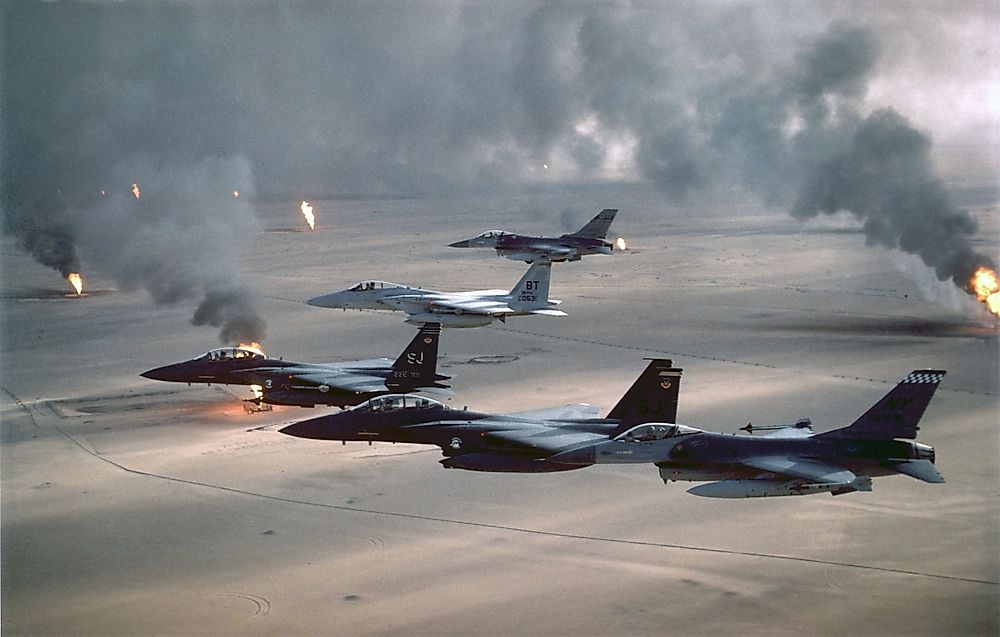What Was Operation Desert Storm?

Introduction
On August 2, 1990, the Iraqi military conducted a 2-day campaign to annex Kuwait and claim the natural resources and land for Iraq. The initial operation was a resounding success, and the Iraq armed forces occupied the entire neighboring country as well as overrunning the majority of the Kuwait army. The invasion resulted in a seven month Iraqi occupation of Kuwait, and many from the country fled to Saudi Arabia or Bahrain. The invasion was costly for the Kuwaiti army, losing 4,200 troops on the battlefield as well as some 12,000 were captured by the invading Iraqi army who suffered minor casualties in comparison. Kuwait was also declared as the "19th Province of Iraq" by dictator Saddam Hussein.
Hussein, the Iraqi leader at the time, and his country had recently come to the end of a costly and bloody war with Iran and had racked up enormous debt from Kuwait during this period of war. Kuwait sought to curb the influence of a revolutionary Islamic state like Iran and agreed to finance a significant portion of the Iraq war effort in this conflict. This debt was thought to be as much as USD 14 billion and the country needed to recover somehow and pay-back some of this enormous debt. Iraq's financial struggles during this time were often blamed on neighboring countries as a way to deflect criticism from Saddam Hussein. After asking Kuwait to forgive the debt and Kuwait refusing this request, Hussein began to start various diplomatic spats with their neighbor. Kuwait had begun to produce what Hussein felt was too much petroleum, creating a dent in his country's profit from oil due to an increased supply. Hussein also accused Kuwait of slant-drilling oil from Iraqi land, blaming them for stealing Iraqi national resources, which to him, amounted to a declaration of war. All of these factors lead to the decision to invade Kuwait.
Build-up and Commencement Of Operation Desert Storm
The United Nations swiftly condemned Iraq's invasion of a sovereign nation and issued economic sanctions as well as a resolution denouncing the actions of Hussein and calling for a withdrawal. As discussed above, Iraq successfully invaded Kuwait and occupied the country for seven months, effectively ignoring the United Nations. This lead to the United States leading a military coalition of 39 different countries after the United Nations had authorized the use of force in late 1990. Before conducting the military operation, the United States built-up troops in Saudi Arabia to deter Iraq from attacking yet another country. In January of 1991, the coalition troop build-up in Saudi Arabia had reached upwards of 700,000, ready to attack the Iraqi forces who had yet to withdraw from Kuwait.
To ensure the Iraqi army would be sufficiently weakened before launching the counter-invasion, the Coalition started a vicious aerial bombardment of Iraq as well as Iraqi forces in Kuwait. The sustained air campaign from the Coalition targeted Iraqi air-defense systems, communications systems, government buildings, oil fields, and vital bridges and roads. February 24th, 1991 signified the first day of the ground campaign with coalition troops attacking the Iraqi armed forces in Kuwait and also attacking from the Iraq/Saudi Arabia border. After just three days of the ground campaign, Kuwait was liberated and on February 27, 1991, Coalition troops stopped attacking Iraqi forces after learning they were to comply with the original United Nations resolution. April 6, 1991, marked the day that Iraq accepted the terms of a cease-fire agreement and the First Gulf War formally ended.
Consequences And Cost Of Operation Desert Storm
The financial cost of the war to the United States of America was estimated at USD 61.1 billion, although the majority of this was paid back by other countries. A combined $36 billion was paid to the United States by Kuwait, Saudi Arabia, and other Gulf nations. Some of this payment was not monetary but service-related such as food and transport while United States troops were based in Saudi Arabia. Since United States forces represented almost three-quarters of the troops fighting the conflict, the country absorbed a lot of the initial costs.
While retreating from Kuwait, the Iraqi armed forces enacted what is known as a "scorched earth: policy", destroying anything of economic value. The Iraq army subsequently set 700 oil wells on fire in January and February of 1991, and some of these fires were not extinguished until November of the same year. Estimates put losses at approximately 6 million barrels of oil per day and the $1.5 billion Kuwait paid to have the fires extinguished was an enormous sum.
Casualties from both sides were vastly different, as the United States held a distinct advantage with their superior air power and technology. The United States and other Coalition troops sustained 190 troop deaths and 776 injuries on the battlefield. The Iraqi army suffered many, many more casualties with numbers ranging from 20,000-30,000 deaths and as much as 75,000 injured during Operation Desert Storm. This war was the first conflict to be broadcast live around-the-clock, and many media scholars maintain that the coverage of the war was similar to that of a video game, effectively desensitizing the mainstream public to seeing live killings and military operations broadcast on news networks.
Some authors maintain that the invasion of Kuwait in 1991 eventually lead to the United States' 2003 Iraq invasion and occupation due to tactics used by Hussein in the aftermath of the First Gulf War. For example, Kurdish people in the North and Shi'ites in the South of the country saw an opportunity to take advantage of a weakened Iraqi state post Desert Storm. The way in which Hussein had these uprisings dealt with lead to further economic sanctions, a no-fly-zone, as well as a brief bombing campaign against Iraq by the United States in 1998.











